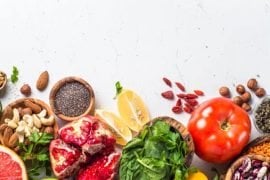I pride myself in being a pretty open-minded dietitian. Yeah, beans and whole grains are important, but sometimes I just need something a little more indulgent. There aren’t too many foods I wouldn’t eat or at least try. There are some not-so-healthy foods I do enjoy for pure nostalgia, knowing this food is serving no health benefits, just joyous reminders of my childhood, or because they’re just delicious. But there are some foods though, that I really do avoid. My decisions ultimately came down to food quality, degree of processing, sodium, sugar and fat content. Here are five foods this registered dietitian would never eat.
And none of us are perfect. We all have our weaknesses. But when it comes to drawing the line, these are five food types that essentially have no nutritional value. In fact, they are so detrimental that I would never eat them.
Here are five foods this registered dietitian would never eat
1. Kids’ Cereals (And Some Adult Cereals too!)
I can just see the situation unfold when I see parents and kids stroll down the cereal aisle; the child sees a new cereal with their favorite character or mascot and proceeds to beg and plead with their mom or dad to get it. Food manufacturers and grocers are smart; they purposefully stock kids’ cereals on the lower shelves so that they are at direct eye-level for them. Unfortunately, they pack these cereals with too many added sugars. Added sugars are purely extra, non-nutritive calories; they offer no health benefits, and are a health deterrent. Excess sugar/calorie intake can be linked to an increased risk of obesity, inflammation, heart attack, stroke, diabetes, and dental cavities. Making it an easy addition to a list of foods this registered dietitian would never eat.
Folks 2 years and older should limit their added sugar intake to no more than 10% of their total calories for the day. So if you consume ~1800 calories each day, aim to eat less than 45g of added sugar daily. As a reference, a 12oz can of cola is about 40g of added sugar. As I mentioned before, this is not limited to kids’ cereals. Some adult cereals are just as guilty of excessive added sugar content. A good rule of thumb is to choose a few cereals to compare their added sugar and with the least amount of added sugars, or no more than 9g of added sugars.
Always look at the ingredient list
Choose another cereal if sugar (or any of its other names- corn syrup, dextrose, brown sugar, etc) is listed in the top 3 ingredients. Your first meal of the day should not be a sugar bomb. We need to properly fuel our bodies for the busy morning that lies ahead.
2. Deep Fried Desserts
A carnival favorite. Deep fried desserts usually make an appearance at various beach boardwalks, festivals, fairs and theme parks. I’m talking about those certain cookies and candies that have been battered and deep fried. Some folks experimented with deep frying ice cream and cheesecake too. (None of those would be foods this registered dietitian would eat.) Donuts and churros are in a different category as the frying process defines these desserts.
Desserts have a time and place. Believe me, I love dessert.
But I’m more of a purist. I like desserts in a much more natural form. I understand that candy, cheesecake and cookies are not offering anything beneficial. They are loaded with saturated fat and sugar. I can accept that. Adding batter and deep frying is adding more unnecessary saturated fats and calories to an already unhealthy food item. The American Heart Association recommends limiting your saturated fat intake to 5-6% of your total calories. Excess saturated fat can increase heart disease risk by raising bad (LDL) cholesterol. For me, it’s enough to enjoy that piece of candy or slice of cake without having to go overboard.
Also Read: These are the 10 healthiest foods you can buy at Costco
3. Cheese from a Can
I love cheese. There, I said it. I enjoy browsing the cheese section at stores and trying new kinds and flavors. And I appreciate the different flavors, textures, and creaminess of cheese. Especially when pairing it with grapes and crackers. But don’t be fooled. I’m talking about real cheese here. The key is enjoying it on occasion. Canned cheese, on the other hand, is one of the most highly processed foods out there. I do not entertain the thought of adding it to my grocery cart. Honestly this is a food that probably no other registered dietitians would eat.
I was looking at the ingredient list of a popular aerosol cheese brand. (Which will remain nameless.) Where do you think cheese landed on that list? First? Nope. Second? Not even close. OK, I’ll tell you. Fourth! The FDA lists ingredients in order of amount. So the first ingredient is what a product contains the most of. The second ingredient is the second most, and so on. For a canned “cheese” product the have cheese as the fourth ingredient tells you everything you need to know.
It contained multiple artificial ingredients and preservatives too. A serving of canned cheese provides over 400 mg of sodium, while a 1 oz slice of cheddar cheese has about 180 mg of sodium. If I want cheese, I’d rather indulge in the real thing rather than settle for a highly processed spray cheese.
Product Review: Goldthread Tonics Turmeric Radiance
4. (Most) TV Dinners
I understand the convenience of TV or ready-to-eat frozen meals. They’re a fast option when you’re busy or maybe forgot to go to the grocery store. They are also an easy choice if you hate cooking or don’t feel confident in your abilities. Their sodium content, however, makes me salty. Food manufactures use sodium for flavor and to help preserve foods.
However, our Western diets are already sodium heavy, from the lunchmeat, condiments, cheese, bread and rolls we use for sandwiches to the crackers, chips, and pretzels we like to snack on. Most frozen meals have tons of sodium. (Even the “healthy” ones.) Some include almost half our daily recommended intake. That depends on the brand and dish, of course. But no matter what, that is just for one meal. And excess sodium has been linked to an increased risk of hypertension — or high blood pressure. Uncontrolled hypertension overtime increases risk for heart attack, stroke, and kidney disease. It can cause vascular and organ damage too.
The American Heart Association recommends limiting sodium intake to no more than 2300mg/day, with an ultimate goal of no more than 1500mg/day. I like recommending low sodium or “no added salt” versions of foods, when able, to help control sodium intake. With frozen meals, try to choose meals with less than 600mg of sodium per serving.
A helpful tip for one of the foods this registered dietitian would never eat
If a frozen meal comes with a sauce packet, don’t use the whole thing. You will find the majority of sodium in the sauces. Or, even better, create your own seasoning with different spices and herbs, vinegars, lemon or lime juice. (It will actually taste even better.)
Also Read: These are the 7 best canned fish brands on the market
5. Super Sized Anything
Overtime, portions of foods have increased in America. A study in the American Journal of Public Health found that portion sizes of pastas, sodas, baked goods, fast-food burgers and fries have dramatically increased since the 1970s. According to the World Health Organization (WHO), “a direct, causal relationship between portion size and obesity has not been demonstrated, current research indicates that energy intake in children and adults is influenced by the size of the served portion, with larger served portions resulting in significant increases in energy intake.”
OK, this isn’t technically one of the foods this registered dietitian would never eat – but you get the point
Supersizing anything is going to increase our overall calorie intake, and can increase weight-gain risk if these supersized foods are energy dense such as baked goods, sodas, fast food, chips, etc.
Increased portions lead to overeating.
I’m a firm believer in the “everything in moderation” cliche. The problem is, we have totally skewed our sense of portions and moderation. Many food companies are promoting larger portions (think gas station sodas and value meals at fast food restaurants) as a better bang for your buck. Over time this can alter what we think of as a normal portion, and therefore we unknowingly increase our calorie intake. It is best practice then, to be mindful of our portions and avoid excessively large portions. Choose a smaller-size drink, a kids meal option, and use a smaller plate. When dining out, take half your meal home with you, or split your dish with someone. Look at your bag of chips, if a serving is 13 chips, count them out to see how much of these foods you are eating.
Foods this Registered Dietitian Would Never Eat – In Conclusion
It’s important to be mindful of our food choices. We stock our grocery stores with overly-processed, high fat, high salt, high sugar foods. Why? Because that’s what most Americans find palatable. Also, it’s cheap for manufacturers to produce too, which is cost-effective for consumers. As I said before, there’s a time and place for most foods. But the over-processed, overly-indulgent foods like those listed above I avoid. For me, these foods have gone overboard. They are so far from their original form, that their sodium, fat and sugar content are unappealing. They can increase risk for heart attacks, strokes, diabetes, inflammation and kidney disease. We should fuel our body with good food and indulge in moderation.

Christine Morgan is a Registered and Licensed Dietitian who currently practices in dialysis. Her experience includes renal nutrition, food service, and geriatrics. Her education includes a Bachelor of Science in Nutrition and Dietetics from West Chester University of Pennsylvania, and she completed her Dietetic Internship with the University of Delaware. She is also a member of the Tri-State Renal Dietitians Association.





